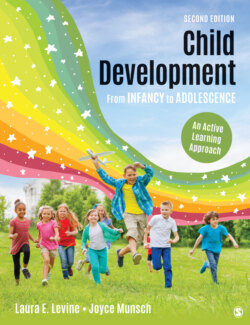Читать книгу Child Development From Infancy to Adolescence - Laura E. Levine - Страница 142
На сайте Литреса книга снята с продажи.
The Scientific Method
ОглавлениеChild development is one of many disciplines that use the scientific method to add to their body of knowledge. Researchers begin by asking a question (often based on theories), next they identify the factors or elements that need to be examined to answer that question, and then they put their question to the test. Based on what they find, they can accept or reject the premise on which the original question was based. Most often their results lead to further questions to be tested. Each of these steps is described in more detail in the remainder of this chapter.
Research often begins with observing a behavior we are interested in understanding. In trying to make sense of what we see, we draw on theories to formulate a testable prediction, called a hypothesis, about the nature and causes of the behavior. Before we can test our ideas, however, we need to decide how we will measure the behavior we want to study. If, for example, we are interested in studying aggression, we need to decide which observable behaviors will fit the way we conceptualize “aggression.” We can include physical aggression, such as hitting or biting, but we need to decide whether we also want to include verbal aggression, such as name-calling, or relational aggression, such as excluding someone from a group activity. Deciding what we will include and what we will exclude is called operationalizing a concept.
Hypothesis: A prediction, often based on theoretical ideas or observations, and tested by the scientific method.
Operationalizing a concept: Defining a concept in a way that allows it to be measured.
Two essential characteristics of any measure used in scientific research are reliability and validity. A measure is reliable when it produces the same or similar results each time it is used. For example, if we use a measure of self-esteem, we would expect a given child or adolescent to score at about the same level if we administered the measure on several occasions. We also need to be sure a measure is valid, that is, it measures what it purports to measure. If researchers used a test of mathematical skill as a measure of general intelligence, you would probably question the validity of their measure because this one ability is too narrow to be a valid measure of general intelligence.
Reliability: The ability of a measure to produce consistent results.
Validity: The ability of a research tool to accurately measure what it purports to measure.
Another important decision involves choosing a sample of participants for our research. We try to make samples representative of the population we are interested in, because we want our research to do more than say something about the particular group of children or adolescents who take part in our research. We want to be able to generalize our results from a particular sample to a larger population, but we must be careful how we take this step. For example, if we conduct research in kindergartens in suburban schools, we need to be careful not to mistakenly assume that our findings would apply equally to children from social, economic, or ethnic backgrounds that are very different from those of the children we studied. We might not find the same results if we studied children from low-income families enrolled in a Head Start program, or children from higher-income families enrolled in an expensive private school.
Finally, our confidence that the conclusions we draw from our study are valid is strengthened if results are replicated or repeated in subsequent research. We can do this by repeating the research using other groups that are the same or similar to the group we originally studied, or by extending the research to new groups to see whether the conclusions can be generalized to them. We also expect that other researchers will be able to conduct their own independent research and come to the same or similar conclusions (Makel, Plucker, & Hegarty, 2012). When there are a number of studies on the same topic, a statistical procedure called meta-analysis can be used to combine the data and determine whether there is a consistent pattern of findings across them.
Meta-analysis: A statistical procedure that combines data from different studies to determine whether there is a consistent pattern of findings across studies.
